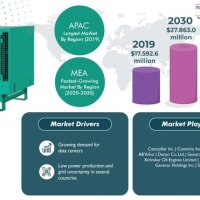The hydrogen storage market is expected to grow to $991.7 million by 2026 at a 7.6% CAGR during the forecast period (2016–2026), witnessing a huge increase in revenue from $477.7 million in 2016. The increasing demand for low-emission fuels, deployment of hydrogen storage tanks in the transportation sector, and rising ammonia and methanol consumption worldwide are driving the market. Hydrogen storage is a technology that has enabled the advancement of the fuel cell and hydrogen technologies, which are then used as portable power and stationary power and in transportation.
The hydrogen storage market is witnessing the trend of increasing research and development activities. Countries such as India, the U.K., and the U.S. are developing advanced hydrogen and fuel cell technologies. This is enabling the development of adequate hydrogen storage for material-handling equipment, light-duty vehicles, and portable power applications. Further, in collaboration with the U.S. Department of Energy, the National Renewable Energy Laboratory is developing high-performance, cost-effective hydrogen and fuel cell technologies for portable and stationary power and transportation.
Get free sample copy of report at: http://bit.ly/2PfjD8z
The increasing investments in the fuel cell and hydrogen technologies hold a massive potential for the hydrogen storage market. Further, governments are also coming up with supportive initiatives to popularize the adoption of these technologies. Europe and North America are increasingly focusing on producing zero-emission hydrogen vehicles, for which the U.K. and the U.S. released funds to boost the hydrogen-fueled vehicle manufacturing. The high demand for methanol and ammonia and stringent emission policies in India, South Korea, Japan, and China are further predicted to boost the market growth.
One of the factors affecting the hydrogen storage market growth positively is the extensive use of hydrogen storage tanks in the transportation sector. Owing to high storage performance and cost-effectiveness, hydrogen storage tanks are preferred to power fuel cell and electric vehicles. The World Nuclear Association mentioned that the demand for hydrogen for producing transport fuels from crude oil would witness an increase in the coming years. Also, the volatile prices of crude oil are a big factor driving the demand for hydrogen as transport fuel.
The segments of the hydrogen storage market are region, form of storage, application, and type of storage. Based on storage, the bifurcations of the market are material-based and physical storage. The larger market revenue share in the historical period (2012–2015) was accounted for by the physical storage type. This is credited to the increasing application of hydrogen in various sectors, such as ammonia production, crude oil refining, metalworks, glass production, and transportation. The physical storage form is expected to continue leading the market in the forecast period.
Based on application, the categories of the hydrogen storage market are transportation, portable power, and stationary power. Owing to the surging demand for hydrogen for generating energy and the popularity of hydrogen storage applications in grocery stores, airports, and data centers, the stationary power category generated the highest revenue during the historical period. During the forecast period, the highest value CAGR is predicted to be exhibited by the transportation power category on account of the increasing usage of hydrogen as fuel in vehicles.
Therefore, the market for hydrogen storage is set to witness significant growth in the forecast period due to technical advancements in the field of energy storage.
Key players entering into collaborations for technological developments
The key players in the hydrogen storage market include Linde AG, Air Liquide S.A., Worthington Industries Inc., Praxair Inc., HBank Technologies Inc., McPhy Energy S.A., VRV S.p.A., Hexagon Composites ASA, and INOXCVA.
Contracts and agreements have been the major developments in the global hydrogen storage market in recent years. Worthington Industries Inc., Praxair Inc., and Linde AG are some of the companies that signed new agreements for the development of hydrogen storage technologies around the world.
The hydrogen storage market is witnessing the trend of increasing research and development activities. Countries such as India, the U.K., and the U.S. are developing advanced hydrogen and fuel cell technologies. This is enabling the development of adequate hydrogen storage for material-handling equipment, light-duty vehicles, and portable power applications. Further, in collaboration with the U.S. Department of Energy, the National Renewable Energy Laboratory is developing high-performance, cost-effective hydrogen and fuel cell technologies for portable and stationary power and transportation.
Get free sample copy of report at: http://bit.ly/2PfjD8z
The increasing investments in the fuel cell and hydrogen technologies hold a massive potential for the hydrogen storage market. Further, governments are also coming up with supportive initiatives to popularize the adoption of these technologies. Europe and North America are increasingly focusing on producing zero-emission hydrogen vehicles, for which the U.K. and the U.S. released funds to boost the hydrogen-fueled vehicle manufacturing. The high demand for methanol and ammonia and stringent emission policies in India, South Korea, Japan, and China are further predicted to boost the market growth.
One of the factors affecting the hydrogen storage market growth positively is the extensive use of hydrogen storage tanks in the transportation sector. Owing to high storage performance and cost-effectiveness, hydrogen storage tanks are preferred to power fuel cell and electric vehicles. The World Nuclear Association mentioned that the demand for hydrogen for producing transport fuels from crude oil would witness an increase in the coming years. Also, the volatile prices of crude oil are a big factor driving the demand for hydrogen as transport fuel.
The segments of the hydrogen storage market are region, form of storage, application, and type of storage. Based on storage, the bifurcations of the market are material-based and physical storage. The larger market revenue share in the historical period (2012–2015) was accounted for by the physical storage type. This is credited to the increasing application of hydrogen in various sectors, such as ammonia production, crude oil refining, metalworks, glass production, and transportation. The physical storage form is expected to continue leading the market in the forecast period.
Based on application, the categories of the hydrogen storage market are transportation, portable power, and stationary power. Owing to the surging demand for hydrogen for generating energy and the popularity of hydrogen storage applications in grocery stores, airports, and data centers, the stationary power category generated the highest revenue during the historical period. During the forecast period, the highest value CAGR is predicted to be exhibited by the transportation power category on account of the increasing usage of hydrogen as fuel in vehicles.
Therefore, the market for hydrogen storage is set to witness significant growth in the forecast period due to technical advancements in the field of energy storage.
Key players entering into collaborations for technological developments
The key players in the hydrogen storage market include Linde AG, Air Liquide S.A., Worthington Industries Inc., Praxair Inc., HBank Technologies Inc., McPhy Energy S.A., VRV S.p.A., Hexagon Composites ASA, and INOXCVA.
Contracts and agreements have been the major developments in the global hydrogen storage market in recent years. Worthington Industries Inc., Praxair Inc., and Linde AG are some of the companies that signed new agreements for the development of hydrogen storage technologies around the world.




















※コメント投稿者のブログIDはブログ作成者のみに通知されます